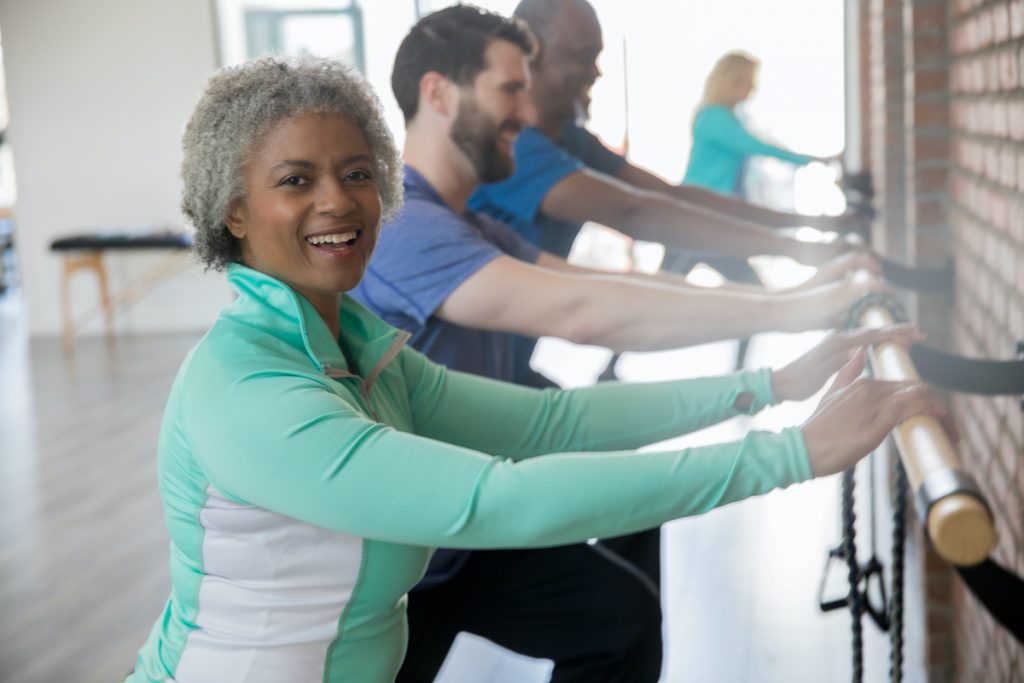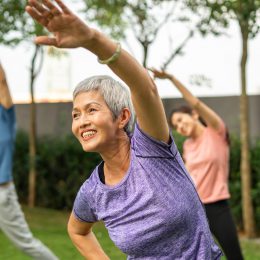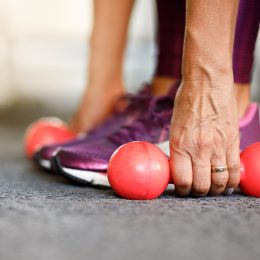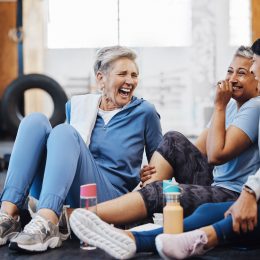Barre Workouts: What to Know Before You Go
This low-impact, ballet-inspired workout combines strength, stretching, and cardio for an awesome body and mind challenge.

Fitness practices rooted in dance forms have been popular since before Richard Simmons had people “Sweatin’ to the Oldies.” But more recently, ballet-inspired barre workouts have popped up everywhere from boutique fitness studios to YouTube. Elements of barre workouts even show up in the popular SilverSneakers LIVE Yoga Pilates Fusion online classes.
Fans love the way the movements help sculpt strong, lean muscles, while improving flexibility, posture, and your mind-body connection.
“Barre has roots in ballet, but you don’t have to be a professional ballet dancer to do this workout,” says Sharlyn Green, a SilverSneakers Master Trainer and certified yoga teacher who leads several Yoga Pilates Fusion classes each week.
“Barre is for everyone. And you’ll come away from it feeling happier and stronger,” Green continues. “It’s such a logical marriage of styles. ‘Long and strong’ is what I like to call this class.”
Here’s everything you need to know about barre and its many health benefits. As always, safety is key. Speak to your health care provider before beginning any new exercise program. This is especially important if you have a chronic health condition or are recovering from an injury or recent surgery.
Get and stay fit with SilverSneakers! Choose from dozens of different Community classes, visit a participating fitness location, or view the current schedule of SilverSneakers LIVE online classes.
What is a barre workout?
First, let’s make clear what barre isn’t: It’s not a dance technique class.
Rather, barre is a total-body strength workout that relies mostly on bodyweight exercises to build muscle endurance, increase flexibility, and improve agility and balance. In addition to drawing from ballet, the exercises incorporate elements of yoga and Pilates, as well.
In a barre workout class, you’ll perform a series of exercises that alternate isometric holds (a position in which muscles are contracted but remain still) with small pulse-like movements. Typically, you’ll start in standing positions that strengthen the lower body and arms before moving to the floor for core-strengthening moves.
“Think about the posture of a dancer,” Green says. “Their sternum is lifted. Their shoulder blades drop down their back. There’s a little external rotation in the hip. Their spine is in neutral. They have this beautiful posture. Barre workouts bring you into that posture.”
You’ll find subtle differences in different classes and studios. Some barre classes use actual ballet bars. In other classes you’ll use a weighted exercise bar for support. But you can do the exercises at home using the back of a sturdy chair or sofa, countertop, or even the wall.
Holding the barre or other support object helps you keep your balance and protects you from injury.
What are the benefits of a barre workout?
Regular barre workouts can help:
- Increase flexibility and range of motion
- Build muscle strength and endurance
- Improve balance and posture
Plus, because it’s a low-impact workout, it’s gentle on your joints.
“Have you ever seen videos of football players trying to do ballet? Barre can be a very challenging workout!” Green says.
That’s because barre calls on several smaller muscles that don’t always get much attention during traditional strength-training exercises. And for the larger muscle groups that do see a lot of daily action — like your glutes, thighs, and calves — barre workouts involve a higher series of repetitions, so they do a great job of improving the endurance of those big, key muscles.
Barre helps you retain function in your core, shoulders, and hips, she says. The workouts also build the strength and stability needed for brisk walks, hefting groceries, playing with grandkids, or working in the yard. The postures and body alignment taught in barre workouts can help prevent injuries even outside of class.
How does barre benefit the mind?
Like yoga, barre is a movement practice that strengthens both mindfulness and the mind-body connection, Green explains. Instructors will emphasize proper breathing techniques and help you nail down good form.
“These exercises help you feel more mindful and present and focused,” Green says. “If you feel tall and strong and confident, of course that makes your mindset more positive.”
Are barre workouts safe for beginners?
One of barre’s biggest benefits is that it’s a low-impact workout. That means none of the jumping or jarring movements that can be tough on ankles and knees.
It is also incredibly modifiable, making it perfect for all ages and fitness levels. Green has women and men of all fitness levels in her Yoga Pilate Fusion classes.
“Barre allows you to personalize your moves to make sure that the movement is sitting well in your body,” Green says. “You have to be kind to your joints, knees, and hips. I usually give three options for intensity.”
For example, if you struggle with the small pulsing movements, your SilverSneakers instructor will encourage you to stick with the isometric hold until you feel stronger.
If an exercise involves a weight or resistance band, you always have the option to do it without, Green says.
Remember, though, it’s important to check with your doctor before beginning any new exercise program.
What is an example of a barre exercise?
A favorite move of Green’s Yoga Pilates Fusion students is called Rond de Jambe. It’s a French term that means “round of the leg,” and that’s exactly what the exercise entails, she says.
How to do the Rond de Jambe:
- Stand to the side of a chair with your right hand resting on the back of the chair.
- Get into first position, as follows: Stand tall with your feet together. Then, keep your heels together and turn your toes out. When you look down, your feet should form the letter V.
- Extend your left leg out in front of you with your toes facing forward.
- Keep your toes touching the floor as you sweep your left foot around to your side and then behind you, “like a rainbow on the floor,” Green says.
- Keep your torso upright and brace your core while you do this.
- Next, sweep your left foot forward and return to first position.
- Repeat 8 to 12 times.
- Turn around, place your left hand on the back of the chair and do 8 to 12 reps with the right foot.
“The movement is like scooping some peanut butter out of a jar with your toe,” Green explains. “And you can modify for your own hip function. So it can be a small peanut butter jar or a big peanut butter jar.”
Press play to try four more barre exercises:
What are some tips for older adults who are new to barre workouts?
Barre is a safe and effective workout for all ages, Green says. The only caveat she has for people is that it’s very important to listen to your body when you’re doing barre.
Some people throw themselves into a new workout style, clinging to a counter-productive “no pain, no gain,” style of training, she notes. If you don’t listen to the signals your body is giving in barre or any other workout, you run the risk of injury.
“Remember to move within your pain-free range,” she says. “Remember alignment principles to make sure your knees and hips are aligned. Always pay attention to how you feel. That mindfulness element is going to help you stay safe and help you get stronger, faster.”
If you’re ready to try barre for yourself, here are a few things to know ahead of your first class.
Tip #1: Start with a SilverSneakers Yoga Pilates Fusion class
Doing your first barre workout in the welcoming setting of a SIlverSneakers LIVE Yoga Pilates Fusion class will ease any beginner jitters.
Subscribe to our newsletter
It's quick and easy. You could be one of the 13 million people who are eligible.
Already a member? Click to discover our 15,000+ participating locations.
Follow Us
“My members in the LIVE classes love that they don’t have to dress to impress or drive anywhere,” Green says. “They can wake up and get started right away. They can work out in their pajamas.”
Plus, nobody else can see you, so there’s less pressure. And even though you aren’t seeing your classmates in real life, there’s an incredible sense of community, Green says.
“There are a lot of benefits to joining a virtual class, and SilverSneakers classes specifically,” she says. “There are individuals in class from coast to coast, and every state in between.”
View the current schedule and RSVP here. If you’d rather join the Yoga Pilates Fusion class in person, check your participating SilverSneakers locationsto see if it’s offered.
Classes typically run 45 minutes. That may seem like a long workout, but keep in mind it will be split up into standing and floor sections. You’ll have plenty of time to recover between exercises, and some time will be spent on relaxing movements, like stretching and breathing.
Tip #2: You don’t need ballet shoes, but you may want socks.
Many people practice barefoot, but others prefer to do their barre workout in socks, specifically grip socks. It’s up to you. But if you decide to use a yoga mat, Green recommends that you stay barefoot.
“Wearing sneakers on a sticky mat could cause trips and falls,” she says. You can wear sneakers as long as you’re standing on the floor.
Besides yourself and your preferred footwear, all you need is a makeshift barre.
“For my Yoga Pilates Fusion class, I always use a chair as a barre,” Green says. “Sometimes I use a SilverSneakers fitness ball, especially for the Pilates segment of class. But I always have options without it.”
Tip #3: Expect some muscle soreness the next day.
Don’t be fooled by the slower pace of movements and the joint-friendly low-impact nature of barre. The Yoga Pilates Fusion class is an intermediate-level class.
After your first few classes, your muscles may feel a little sore because they’re not used to moving in this way. That’s normal and should go away quickly. However, if you’re experiencing pain, you should stop and rest. Call your doctor if the pain doesn’t go away after you’ve stopped.
But that doesn’t mean you shouldn’t try it if you’re a beginner, Green says. Just make sure to go at your own pace.
It’s a good idea to stretch a little later that same day (in addition to what you’ll do in class) and treat yourself to a soothing warm bath or shower while your muscles recover.
Take Your Favorite SilverSneakers Classes Online!
SilverSneakers members can access live fitness classes and wellness workshops through SilverSneakers LIVE. See the latest schedule and RSVP for classes here.
Not a member? If you have a Medicare Plan, it may include SilverSneakers — at no additional cost. Check your eligibility instantly here.
Not eligible for SilverSneakers? You can still get 200+ free SilverSneakers On-Demand videos and stay in touch with us by creating your online account.





